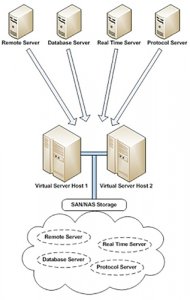Heath Pratt / Manager of SCADA Services / Upwind Solutions / www.upwindsolutions.com
A wind farm typically has several OEM servers operating as a real-time SCADA, database, and remote-access servers. These take up substantial space and require a lot of manpower to ensure peak performance. Some servers at aging wind farms may be close to or out of warranty. At times, the parts needed to support the servers are hard to find and further limited by legacy software restrictions. In the event of a server failure, operators must often reach out to the OEM who in turn installs its own proprietary applications costing tens of thousands.

This shows the migration of the physical servers being migrated into the redundant virtual environment storing the servers in the SAN (Storage Area Network) for the ability to move between either physical virtual hosts.
Here’s what also could happen: A site’s database server crashes and the system is out of warranty. To make this matter worse, required repair parts are no longer available. The only option is to procure and deploy a new system. However, after its installation, technicians cannot get the database to collect data. It is determined that the OEM must restore the site’s database configuration–an expensive task just to resume data acquisition.
One solution is SCADA infrastructure virtualization. It helps owners reduce the number of servers that technicians must support and helps create internal equipment life-cycle plans. In addition, it provides a more efficient, cost effective way to manage a wind-farm’s servers and protect critical infrastructure.
Advantages of infrastructure virtualization include:
- A longer life cycle of critical infrastructure,
- An increased security for NERC while eliminating direct physical access to the actual SCADA service,
- A lower cost of ownership,
- An ability to migrate older legacy servers and software into modern equipment,
- A fewer points of failure with appropriate redundancy,
- A lower support requirements,
- An increased critical infrastructure reliability,
- An ability to migrate into the virtualized environment without needing the OEM,
- An increased ability for testing of patch management offline without impacting production, and
- A faster disaster recovery upon system failures without relying on the OEM.
The number of servers, amount of storage, and the anticipated future growth determines the appropriate infrastructure virtualization hardware for a site. Most commonly, virtual environments consist of two virtual servers, one storage area network, and virtual server licensing.
Planning is the key to success here. Most systems allow for a live migration into the virtual environment with a short outage to make the cut from the physical system to the migrated virtual system. Some systems require scheduled downtime for migration to prevent data loss or corruption, which is common for database servers and protocol (OPC/Modbus) servers.
Once the critical infrastructure is running in the new virtual environment, techs can monitor the health of the virtual server host and the virtualized servers running within. Now upon host failures, the virtual host fails over to the redundant system to prevent a disruption of service, and alerts techs of the failure. At the end of equipment warranties and internal life-cycle programs, each virtual host can also be paused and the session can be resumed on the new virtual host within minutes to avoid downtime and outages.
Virtual environments also provide multiple options to protect servers from disaster. Static failback copies of the servers can be created, along with running backups and snapshots to better guard against complete failures. Restoring or migrating these snapshots allows for faster restoration of servers. WPE
Filed Under: Featured, News, O&M





A better solution is to maintain the SCADA system so that it never gets to a state of obsolescence like this. Don’t get me wrong, building the SCADA servers on a virtual private cloud can be a wonderful way to manage and maintain these systems, However, just like any computing infrastructure that a SCADA system uses, that private cloud infrastructure must be designed and managed to control systems standards, NOT office standards.
I have seen virtualization technologies used successfully to patch and upgrade SCADA systems smoothly; for rapid recovery from hardware failures; and for disaster recovery. However, I do not recommend it for the purpose of keeping old software running on obsolete platforms. That’s a disaster waiting to happen in more ways than I care to enumerate right now.